Report: Conceptual Design of Wastewater Treatment Plant - Bangkok
VerifiedAdded on 2019/11/26
|23
|4789
|269
Report
AI Summary
This report provides a comprehensive conceptual design of a wastewater treatment plant intended for a small town in Bangkok. It encompasses various aspects, including design data, hydraulic analysis, and mass balance calculations. The report details the objectives of the project, background information, and design tasks, such as determining influent flow, wastewater quality, and effluent limits. It outlines the design of different treatment stages, including preliminary, primary, secondary (activated sludge system), and tertiary treatments. The report also covers the design and specifications of individual components like storage pools, screen chambers, grit chambers, sedimentation tanks, aeration tanks, and clarifiers. Additionally, it provides estimations of capital and operational costs, along with a layout of the treatment plant. The report emphasizes the importance of pollutant removal rates and effluent discharge schemes, ensuring the treated water meets the required quality standards. The design considers the specific needs of the location and the expected population growth over a 20-year service life.
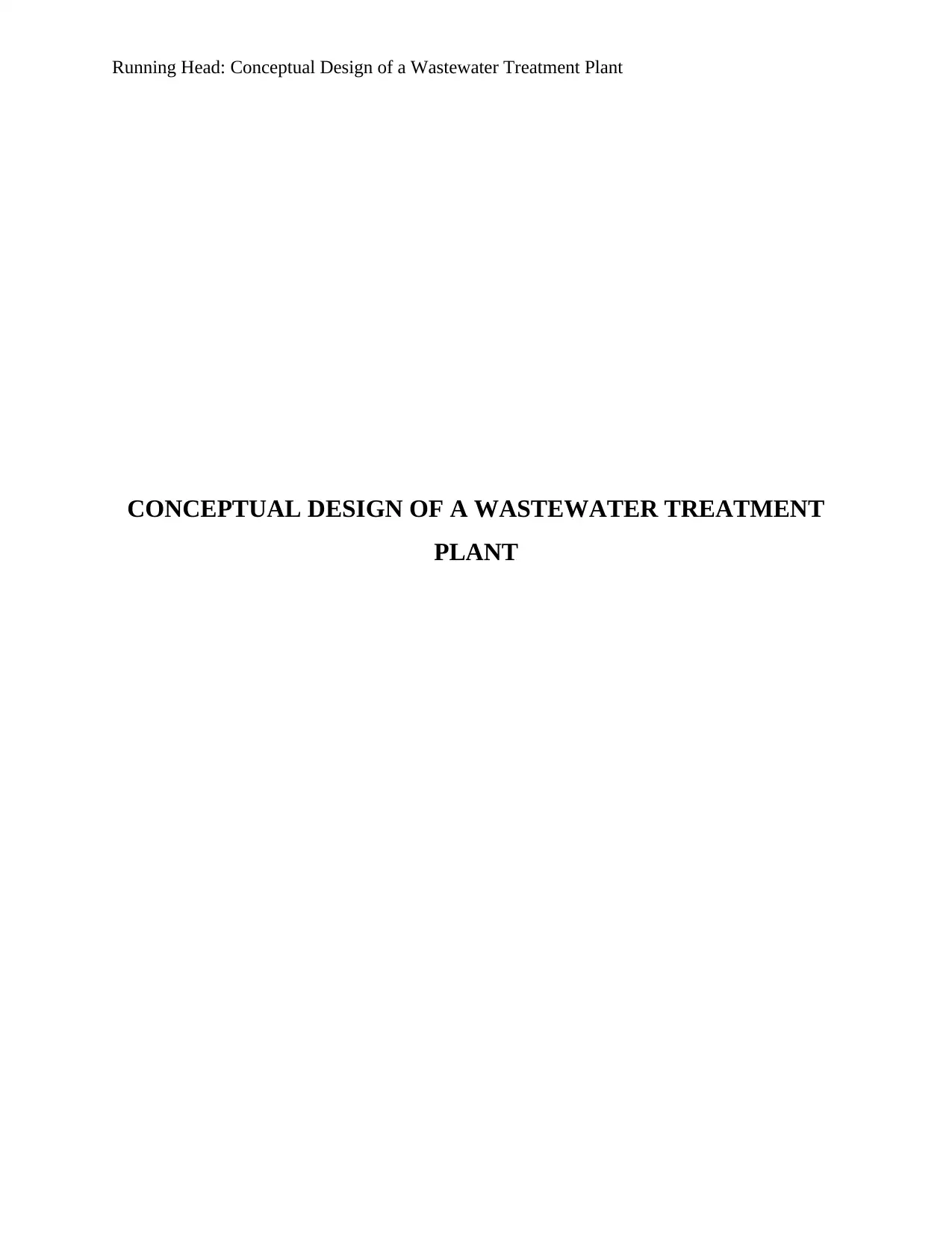
Running Head: Conceptual Design of a Wastewater Treatment Plant
CONCEPTUAL DESIGN OF A WASTEWATER TREATMENT
PLANT
CONCEPTUAL DESIGN OF A WASTEWATER TREATMENT
PLANT
Paraphrase This Document
Need a fresh take? Get an instant paraphrase of this document with our AI Paraphraser
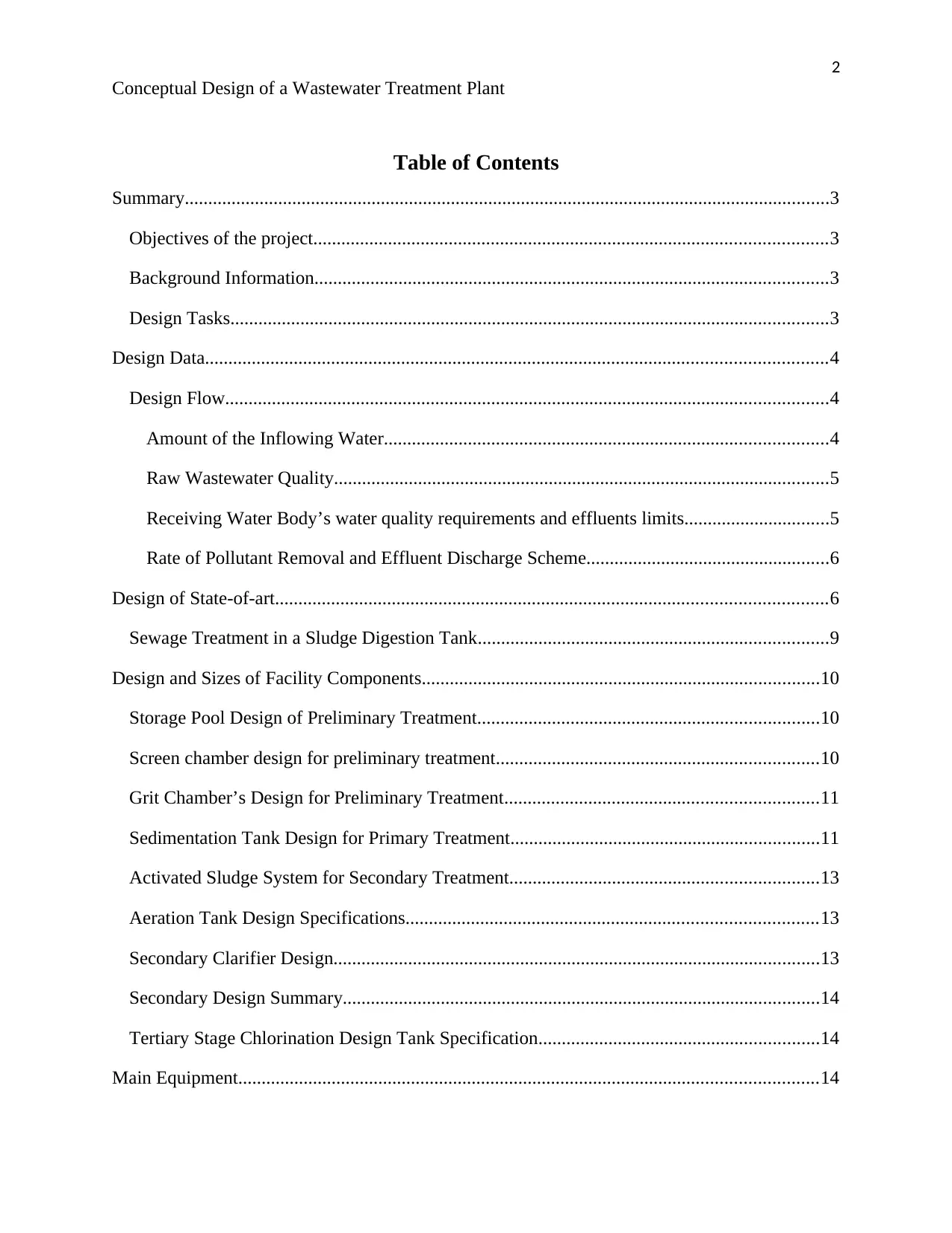
2
Conceptual Design of a Wastewater Treatment Plant
Table of Contents
Summary..........................................................................................................................................3
Objectives of the project..............................................................................................................3
Background Information..............................................................................................................3
Design Tasks................................................................................................................................3
Design Data.....................................................................................................................................4
Design Flow.................................................................................................................................4
Amount of the Inflowing Water...............................................................................................4
Raw Wastewater Quality..........................................................................................................5
Receiving Water Body’s water quality requirements and effluents limits...............................5
Rate of Pollutant Removal and Effluent Discharge Scheme....................................................6
Design of State-of-art......................................................................................................................6
Sewage Treatment in a Sludge Digestion Tank...........................................................................9
Design and Sizes of Facility Components.....................................................................................10
Storage Pool Design of Preliminary Treatment.........................................................................10
Screen chamber design for preliminary treatment.....................................................................10
Grit Chamber’s Design for Preliminary Treatment...................................................................11
Sedimentation Tank Design for Primary Treatment..................................................................11
Activated Sludge System for Secondary Treatment..................................................................13
Aeration Tank Design Specifications........................................................................................13
Secondary Clarifier Design........................................................................................................13
Secondary Design Summary......................................................................................................14
Tertiary Stage Chlorination Design Tank Specification............................................................14
Main Equipment............................................................................................................................14
Conceptual Design of a Wastewater Treatment Plant
Table of Contents
Summary..........................................................................................................................................3
Objectives of the project..............................................................................................................3
Background Information..............................................................................................................3
Design Tasks................................................................................................................................3
Design Data.....................................................................................................................................4
Design Flow.................................................................................................................................4
Amount of the Inflowing Water...............................................................................................4
Raw Wastewater Quality..........................................................................................................5
Receiving Water Body’s water quality requirements and effluents limits...............................5
Rate of Pollutant Removal and Effluent Discharge Scheme....................................................6
Design of State-of-art......................................................................................................................6
Sewage Treatment in a Sludge Digestion Tank...........................................................................9
Design and Sizes of Facility Components.....................................................................................10
Storage Pool Design of Preliminary Treatment.........................................................................10
Screen chamber design for preliminary treatment.....................................................................10
Grit Chamber’s Design for Preliminary Treatment...................................................................11
Sedimentation Tank Design for Primary Treatment..................................................................11
Activated Sludge System for Secondary Treatment..................................................................13
Aeration Tank Design Specifications........................................................................................13
Secondary Clarifier Design........................................................................................................13
Secondary Design Summary......................................................................................................14
Tertiary Stage Chlorination Design Tank Specification............................................................14
Main Equipment............................................................................................................................14
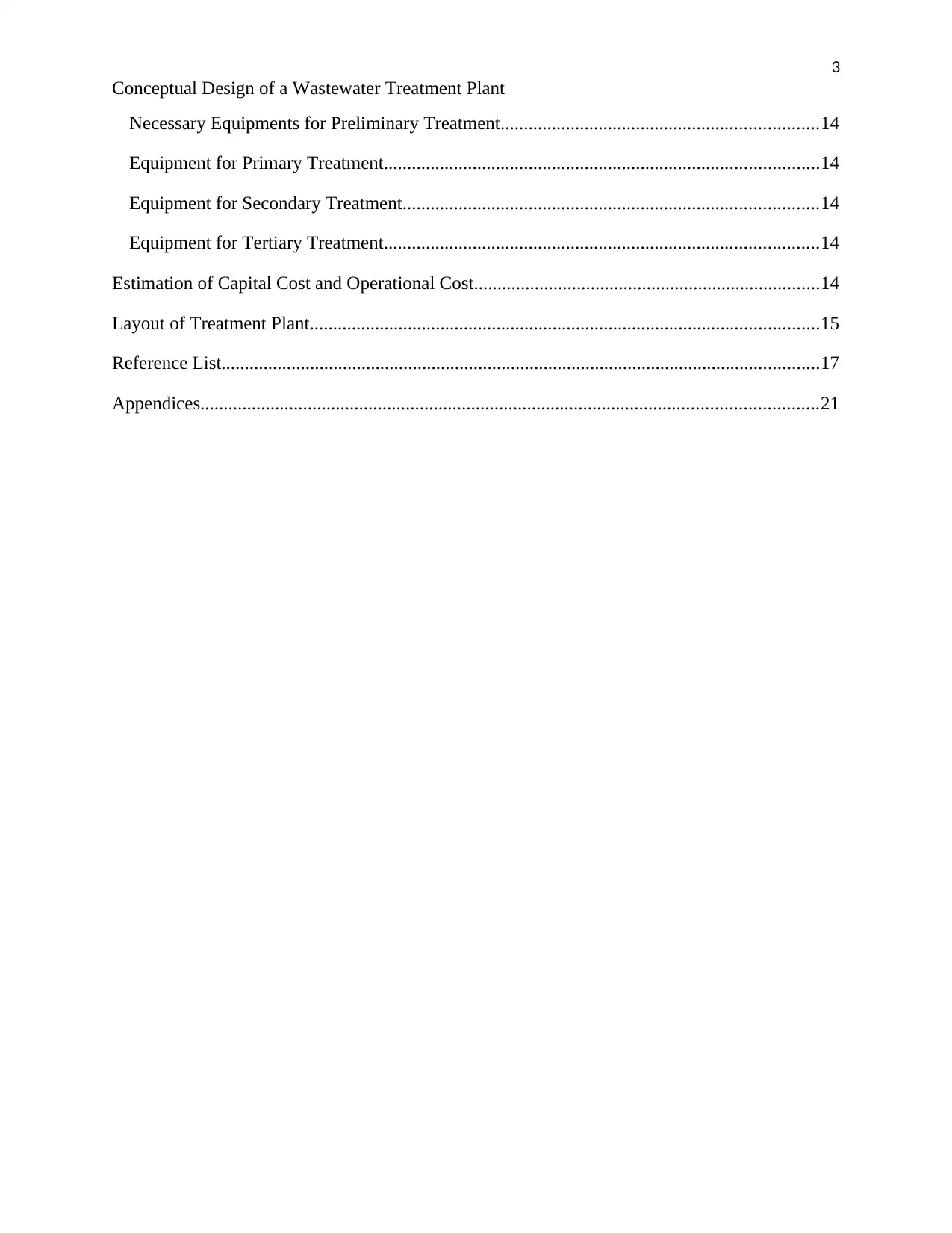
3
Conceptual Design of a Wastewater Treatment Plant
Necessary Equipments for Preliminary Treatment....................................................................14
Equipment for Primary Treatment.............................................................................................14
Equipment for Secondary Treatment.........................................................................................14
Equipment for Tertiary Treatment.............................................................................................14
Estimation of Capital Cost and Operational Cost..........................................................................14
Layout of Treatment Plant.............................................................................................................15
Reference List................................................................................................................................17
Appendices....................................................................................................................................21
Conceptual Design of a Wastewater Treatment Plant
Necessary Equipments for Preliminary Treatment....................................................................14
Equipment for Primary Treatment.............................................................................................14
Equipment for Secondary Treatment.........................................................................................14
Equipment for Tertiary Treatment.............................................................................................14
Estimation of Capital Cost and Operational Cost..........................................................................14
Layout of Treatment Plant.............................................................................................................15
Reference List................................................................................................................................17
Appendices....................................................................................................................................21
⊘ This is a preview!⊘
Do you want full access?
Subscribe today to unlock all pages.

Trusted by 1+ million students worldwide
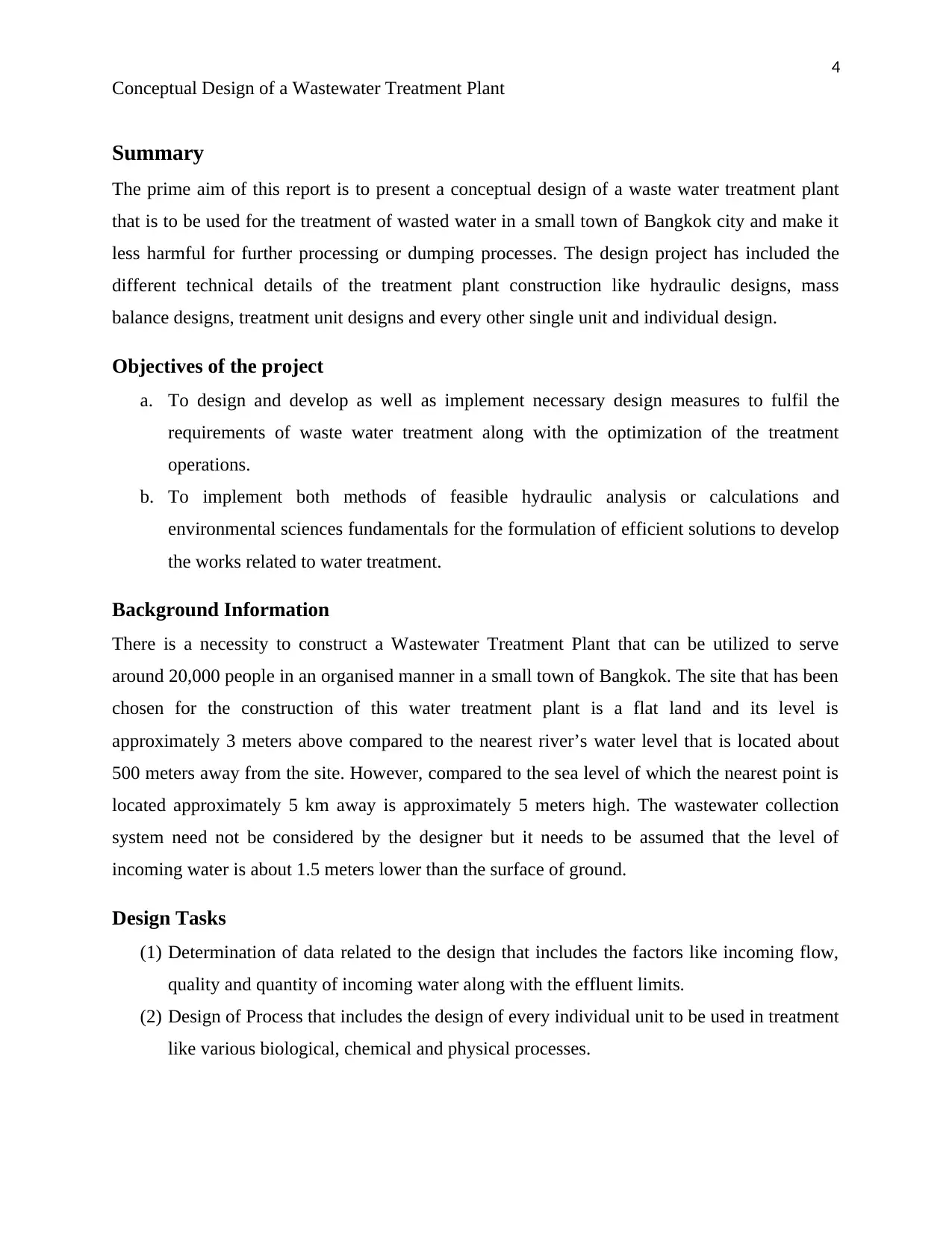
4
Conceptual Design of a Wastewater Treatment Plant
Summary
The prime aim of this report is to present a conceptual design of a waste water treatment plant
that is to be used for the treatment of wasted water in a small town of Bangkok city and make it
less harmful for further processing or dumping processes. The design project has included the
different technical details of the treatment plant construction like hydraulic designs, mass
balance designs, treatment unit designs and every other single unit and individual design.
Objectives of the project
a. To design and develop as well as implement necessary design measures to fulfil the
requirements of waste water treatment along with the optimization of the treatment
operations.
b. To implement both methods of feasible hydraulic analysis or calculations and
environmental sciences fundamentals for the formulation of efficient solutions to develop
the works related to water treatment.
Background Information
There is a necessity to construct a Wastewater Treatment Plant that can be utilized to serve
around 20,000 people in an organised manner in a small town of Bangkok. The site that has been
chosen for the construction of this water treatment plant is a flat land and its level is
approximately 3 meters above compared to the nearest river’s water level that is located about
500 meters away from the site. However, compared to the sea level of which the nearest point is
located approximately 5 km away is approximately 5 meters high. The wastewater collection
system need not be considered by the designer but it needs to be assumed that the level of
incoming water is about 1.5 meters lower than the surface of ground.
Design Tasks
(1) Determination of data related to the design that includes the factors like incoming flow,
quality and quantity of incoming water along with the effluent limits.
(2) Design of Process that includes the design of every individual unit to be used in treatment
like various biological, chemical and physical processes.
Conceptual Design of a Wastewater Treatment Plant
Summary
The prime aim of this report is to present a conceptual design of a waste water treatment plant
that is to be used for the treatment of wasted water in a small town of Bangkok city and make it
less harmful for further processing or dumping processes. The design project has included the
different technical details of the treatment plant construction like hydraulic designs, mass
balance designs, treatment unit designs and every other single unit and individual design.
Objectives of the project
a. To design and develop as well as implement necessary design measures to fulfil the
requirements of waste water treatment along with the optimization of the treatment
operations.
b. To implement both methods of feasible hydraulic analysis or calculations and
environmental sciences fundamentals for the formulation of efficient solutions to develop
the works related to water treatment.
Background Information
There is a necessity to construct a Wastewater Treatment Plant that can be utilized to serve
around 20,000 people in an organised manner in a small town of Bangkok. The site that has been
chosen for the construction of this water treatment plant is a flat land and its level is
approximately 3 meters above compared to the nearest river’s water level that is located about
500 meters away from the site. However, compared to the sea level of which the nearest point is
located approximately 5 km away is approximately 5 meters high. The wastewater collection
system need not be considered by the designer but it needs to be assumed that the level of
incoming water is about 1.5 meters lower than the surface of ground.
Design Tasks
(1) Determination of data related to the design that includes the factors like incoming flow,
quality and quantity of incoming water along with the effluent limits.
(2) Design of Process that includes the design of every individual unit to be used in treatment
like various biological, chemical and physical processes.
Paraphrase This Document
Need a fresh take? Get an instant paraphrase of this document with our AI Paraphraser
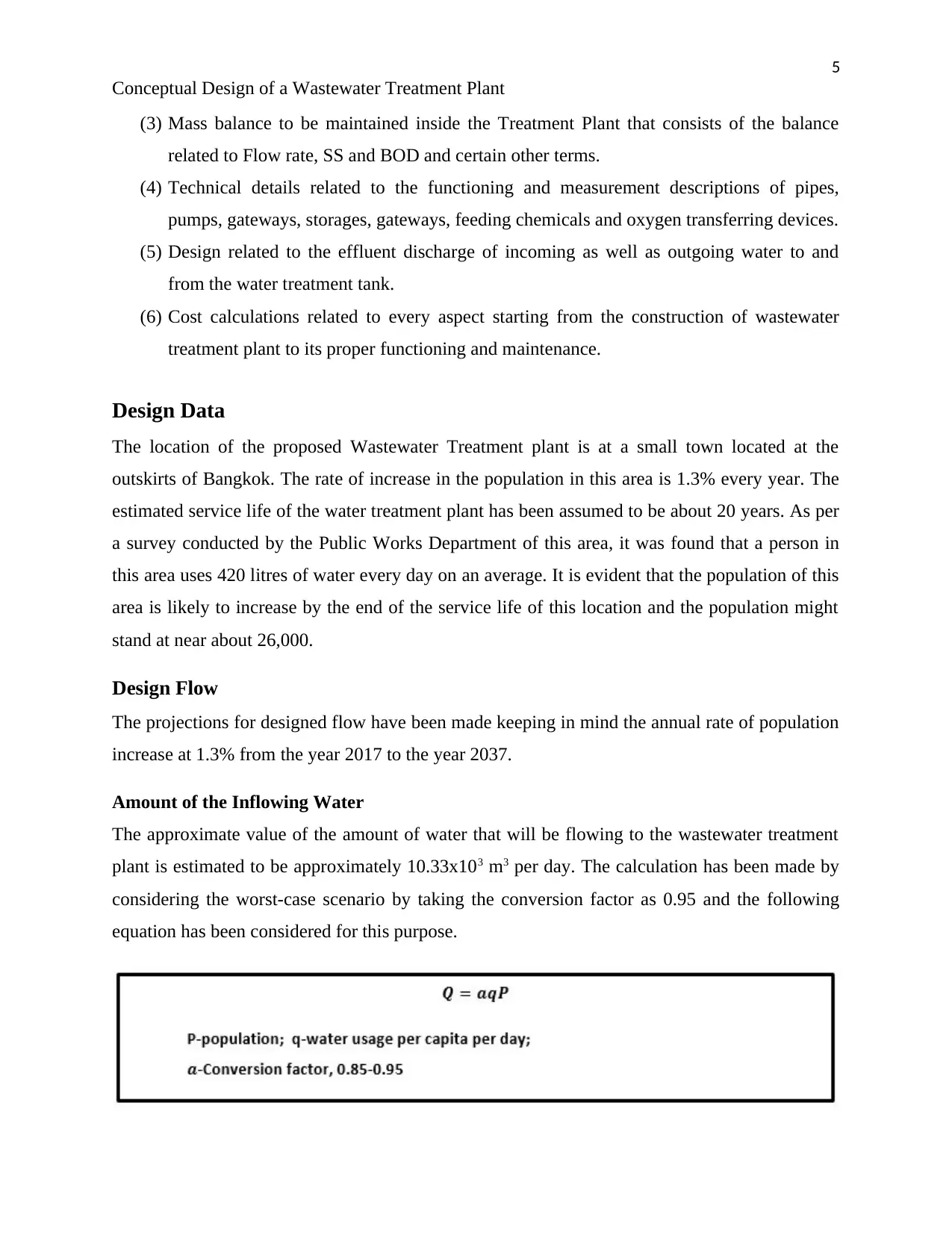
5
Conceptual Design of a Wastewater Treatment Plant
(3) Mass balance to be maintained inside the Treatment Plant that consists of the balance
related to Flow rate, SS and BOD and certain other terms.
(4) Technical details related to the functioning and measurement descriptions of pipes,
pumps, gateways, storages, gateways, feeding chemicals and oxygen transferring devices.
(5) Design related to the effluent discharge of incoming as well as outgoing water to and
from the water treatment tank.
(6) Cost calculations related to every aspect starting from the construction of wastewater
treatment plant to its proper functioning and maintenance.
Design Data
The location of the proposed Wastewater Treatment plant is at a small town located at the
outskirts of Bangkok. The rate of increase in the population in this area is 1.3% every year. The
estimated service life of the water treatment plant has been assumed to be about 20 years. As per
a survey conducted by the Public Works Department of this area, it was found that a person in
this area uses 420 litres of water every day on an average. It is evident that the population of this
area is likely to increase by the end of the service life of this location and the population might
stand at near about 26,000.
Design Flow
The projections for designed flow have been made keeping in mind the annual rate of population
increase at 1.3% from the year 2017 to the year 2037.
Amount of the Inflowing Water
The approximate value of the amount of water that will be flowing to the wastewater treatment
plant is estimated to be approximately 10.33x103 m3 per day. The calculation has been made by
considering the worst-case scenario by taking the conversion factor as 0.95 and the following
equation has been considered for this purpose.
Conceptual Design of a Wastewater Treatment Plant
(3) Mass balance to be maintained inside the Treatment Plant that consists of the balance
related to Flow rate, SS and BOD and certain other terms.
(4) Technical details related to the functioning and measurement descriptions of pipes,
pumps, gateways, storages, gateways, feeding chemicals and oxygen transferring devices.
(5) Design related to the effluent discharge of incoming as well as outgoing water to and
from the water treatment tank.
(6) Cost calculations related to every aspect starting from the construction of wastewater
treatment plant to its proper functioning and maintenance.
Design Data
The location of the proposed Wastewater Treatment plant is at a small town located at the
outskirts of Bangkok. The rate of increase in the population in this area is 1.3% every year. The
estimated service life of the water treatment plant has been assumed to be about 20 years. As per
a survey conducted by the Public Works Department of this area, it was found that a person in
this area uses 420 litres of water every day on an average. It is evident that the population of this
area is likely to increase by the end of the service life of this location and the population might
stand at near about 26,000.
Design Flow
The projections for designed flow have been made keeping in mind the annual rate of population
increase at 1.3% from the year 2017 to the year 2037.
Amount of the Inflowing Water
The approximate value of the amount of water that will be flowing to the wastewater treatment
plant is estimated to be approximately 10.33x103 m3 per day. The calculation has been made by
considering the worst-case scenario by taking the conversion factor as 0.95 and the following
equation has been considered for this purpose.
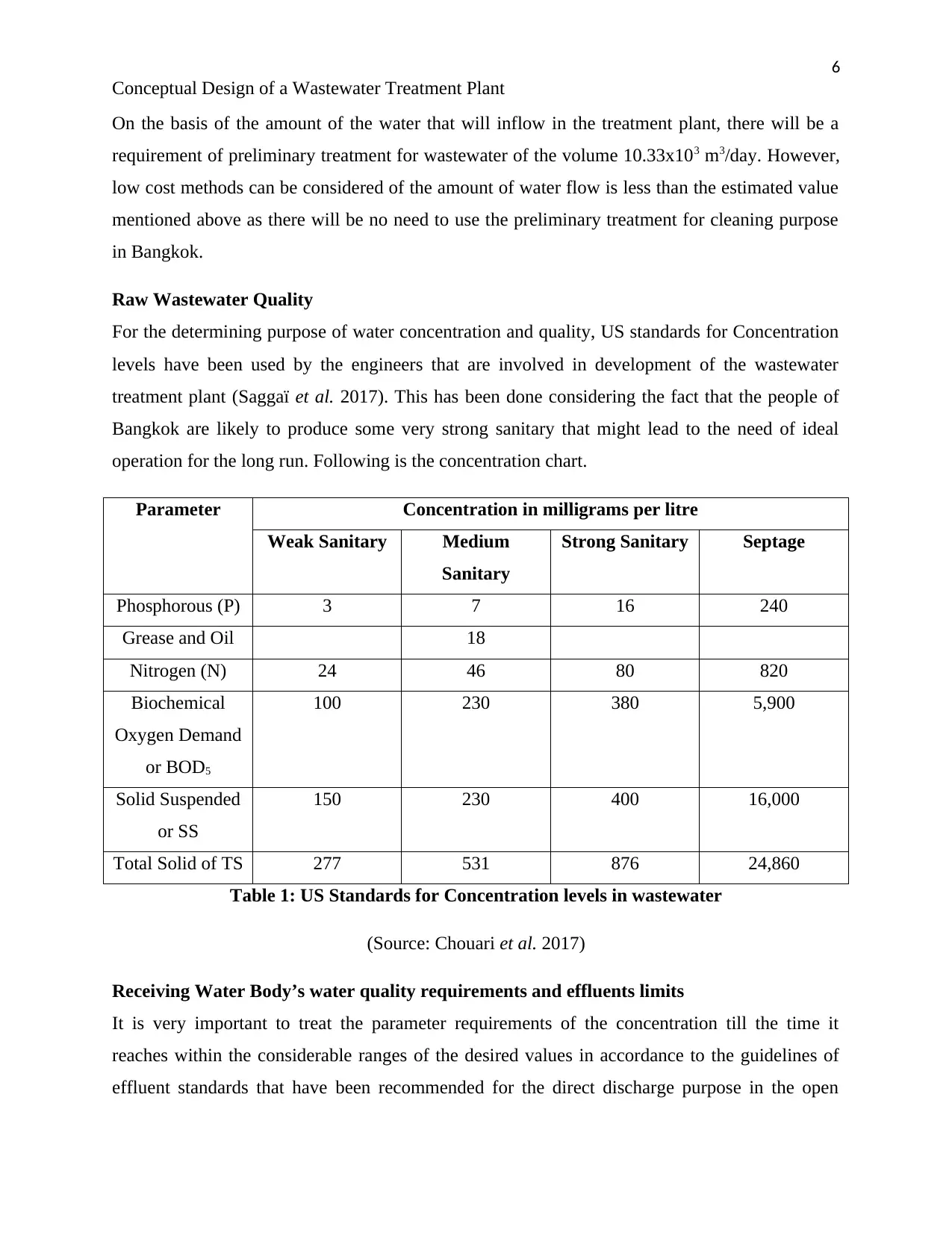
6
Conceptual Design of a Wastewater Treatment Plant
On the basis of the amount of the water that will inflow in the treatment plant, there will be a
requirement of preliminary treatment for wastewater of the volume 10.33x103 m3/day. However,
low cost methods can be considered of the amount of water flow is less than the estimated value
mentioned above as there will be no need to use the preliminary treatment for cleaning purpose
in Bangkok.
Raw Wastewater Quality
For the determining purpose of water concentration and quality, US standards for Concentration
levels have been used by the engineers that are involved in development of the wastewater
treatment plant (Saggaï et al. 2017). This has been done considering the fact that the people of
Bangkok are likely to produce some very strong sanitary that might lead to the need of ideal
operation for the long run. Following is the concentration chart.
Parameter Concentration in milligrams per litre
Weak Sanitary Medium
Sanitary
Strong Sanitary Septage
Phosphorous (P) 3 7 16 240
Grease and Oil 18
Nitrogen (N) 24 46 80 820
Biochemical
Oxygen Demand
or BOD5
100 230 380 5,900
Solid Suspended
or SS
150 230 400 16,000
Total Solid of TS 277 531 876 24,860
Table 1: US Standards for Concentration levels in wastewater
(Source: Chouari et al. 2017)
Receiving Water Body’s water quality requirements and effluents limits
It is very important to treat the parameter requirements of the concentration till the time it
reaches within the considerable ranges of the desired values in accordance to the guidelines of
effluent standards that have been recommended for the direct discharge purpose in the open
Conceptual Design of a Wastewater Treatment Plant
On the basis of the amount of the water that will inflow in the treatment plant, there will be a
requirement of preliminary treatment for wastewater of the volume 10.33x103 m3/day. However,
low cost methods can be considered of the amount of water flow is less than the estimated value
mentioned above as there will be no need to use the preliminary treatment for cleaning purpose
in Bangkok.
Raw Wastewater Quality
For the determining purpose of water concentration and quality, US standards for Concentration
levels have been used by the engineers that are involved in development of the wastewater
treatment plant (Saggaï et al. 2017). This has been done considering the fact that the people of
Bangkok are likely to produce some very strong sanitary that might lead to the need of ideal
operation for the long run. Following is the concentration chart.
Parameter Concentration in milligrams per litre
Weak Sanitary Medium
Sanitary
Strong Sanitary Septage
Phosphorous (P) 3 7 16 240
Grease and Oil 18
Nitrogen (N) 24 46 80 820
Biochemical
Oxygen Demand
or BOD5
100 230 380 5,900
Solid Suspended
or SS
150 230 400 16,000
Total Solid of TS 277 531 876 24,860
Table 1: US Standards for Concentration levels in wastewater
(Source: Chouari et al. 2017)
Receiving Water Body’s water quality requirements and effluents limits
It is very important to treat the parameter requirements of the concentration till the time it
reaches within the considerable ranges of the desired values in accordance to the guidelines of
effluent standards that have been recommended for the direct discharge purpose in the open
⊘ This is a preview!⊘
Do you want full access?
Subscribe today to unlock all pages.

Trusted by 1+ million students worldwide
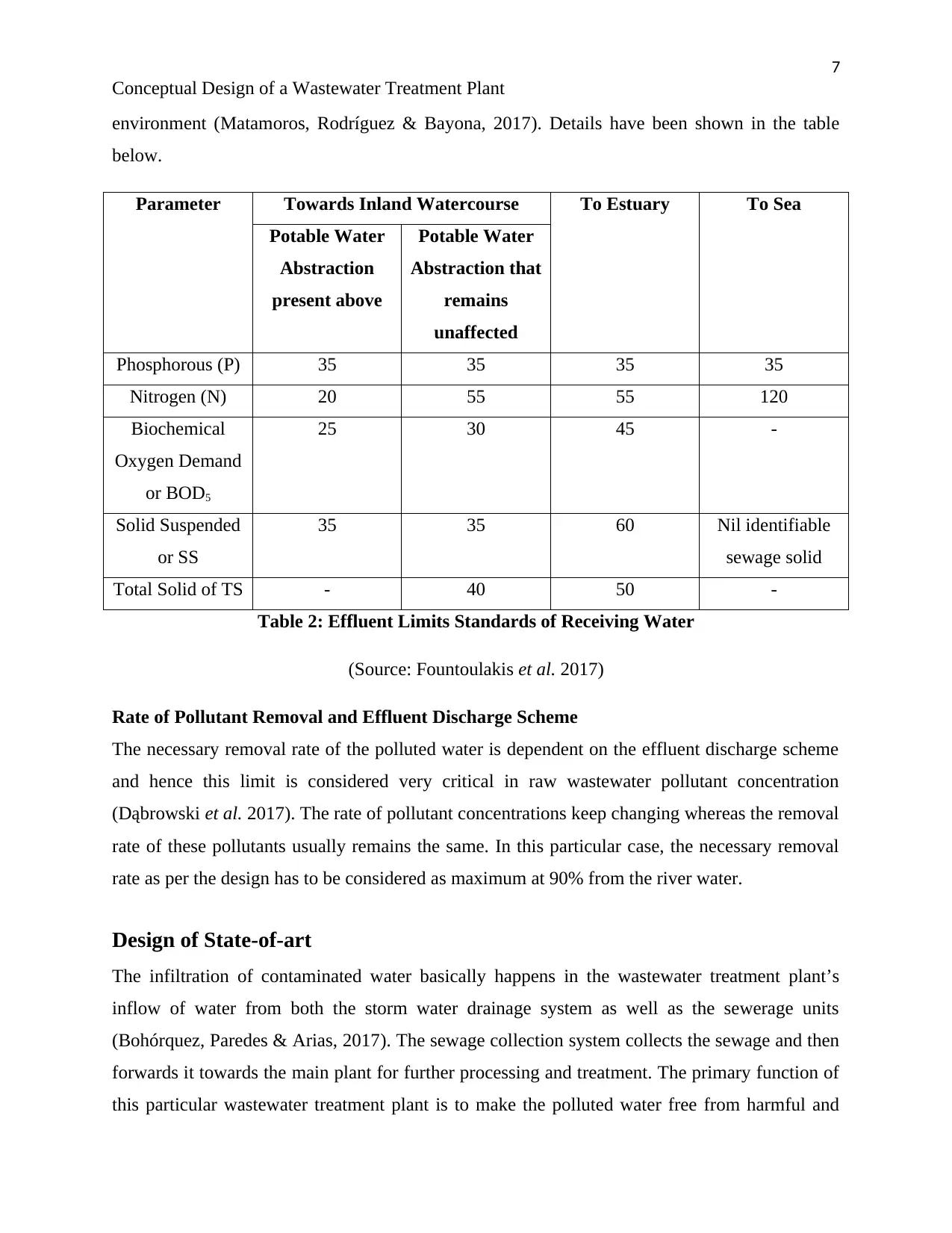
7
Conceptual Design of a Wastewater Treatment Plant
environment (Matamoros, Rodríguez & Bayona, 2017). Details have been shown in the table
below.
Parameter Towards Inland Watercourse To Estuary To Sea
Potable Water
Abstraction
present above
Potable Water
Abstraction that
remains
unaffected
Phosphorous (P) 35 35 35 35
Nitrogen (N) 20 55 55 120
Biochemical
Oxygen Demand
or BOD5
25 30 45 -
Solid Suspended
or SS
35 35 60 Nil identifiable
sewage solid
Total Solid of TS - 40 50 -
Table 2: Effluent Limits Standards of Receiving Water
(Source: Fountoulakis et al. 2017)
Rate of Pollutant Removal and Effluent Discharge Scheme
The necessary removal rate of the polluted water is dependent on the effluent discharge scheme
and hence this limit is considered very critical in raw wastewater pollutant concentration
(Dąbrowski et al. 2017). The rate of pollutant concentrations keep changing whereas the removal
rate of these pollutants usually remains the same. In this particular case, the necessary removal
rate as per the design has to be considered as maximum at 90% from the river water.
Design of State-of-art
The infiltration of contaminated water basically happens in the wastewater treatment plant’s
inflow of water from both the storm water drainage system as well as the sewerage units
(Bohórquez, Paredes & Arias, 2017). The sewage collection system collects the sewage and then
forwards it towards the main plant for further processing and treatment. The primary function of
this particular wastewater treatment plant is to make the polluted water free from harmful and
Conceptual Design of a Wastewater Treatment Plant
environment (Matamoros, Rodríguez & Bayona, 2017). Details have been shown in the table
below.
Parameter Towards Inland Watercourse To Estuary To Sea
Potable Water
Abstraction
present above
Potable Water
Abstraction that
remains
unaffected
Phosphorous (P) 35 35 35 35
Nitrogen (N) 20 55 55 120
Biochemical
Oxygen Demand
or BOD5
25 30 45 -
Solid Suspended
or SS
35 35 60 Nil identifiable
sewage solid
Total Solid of TS - 40 50 -
Table 2: Effluent Limits Standards of Receiving Water
(Source: Fountoulakis et al. 2017)
Rate of Pollutant Removal and Effluent Discharge Scheme
The necessary removal rate of the polluted water is dependent on the effluent discharge scheme
and hence this limit is considered very critical in raw wastewater pollutant concentration
(Dąbrowski et al. 2017). The rate of pollutant concentrations keep changing whereas the removal
rate of these pollutants usually remains the same. In this particular case, the necessary removal
rate as per the design has to be considered as maximum at 90% from the river water.
Design of State-of-art
The infiltration of contaminated water basically happens in the wastewater treatment plant’s
inflow of water from both the storm water drainage system as well as the sewerage units
(Bohórquez, Paredes & Arias, 2017). The sewage collection system collects the sewage and then
forwards it towards the main plant for further processing and treatment. The primary function of
this particular wastewater treatment plant is to make the polluted water free from harmful and
Paraphrase This Document
Need a fresh take? Get an instant paraphrase of this document with our AI Paraphraser
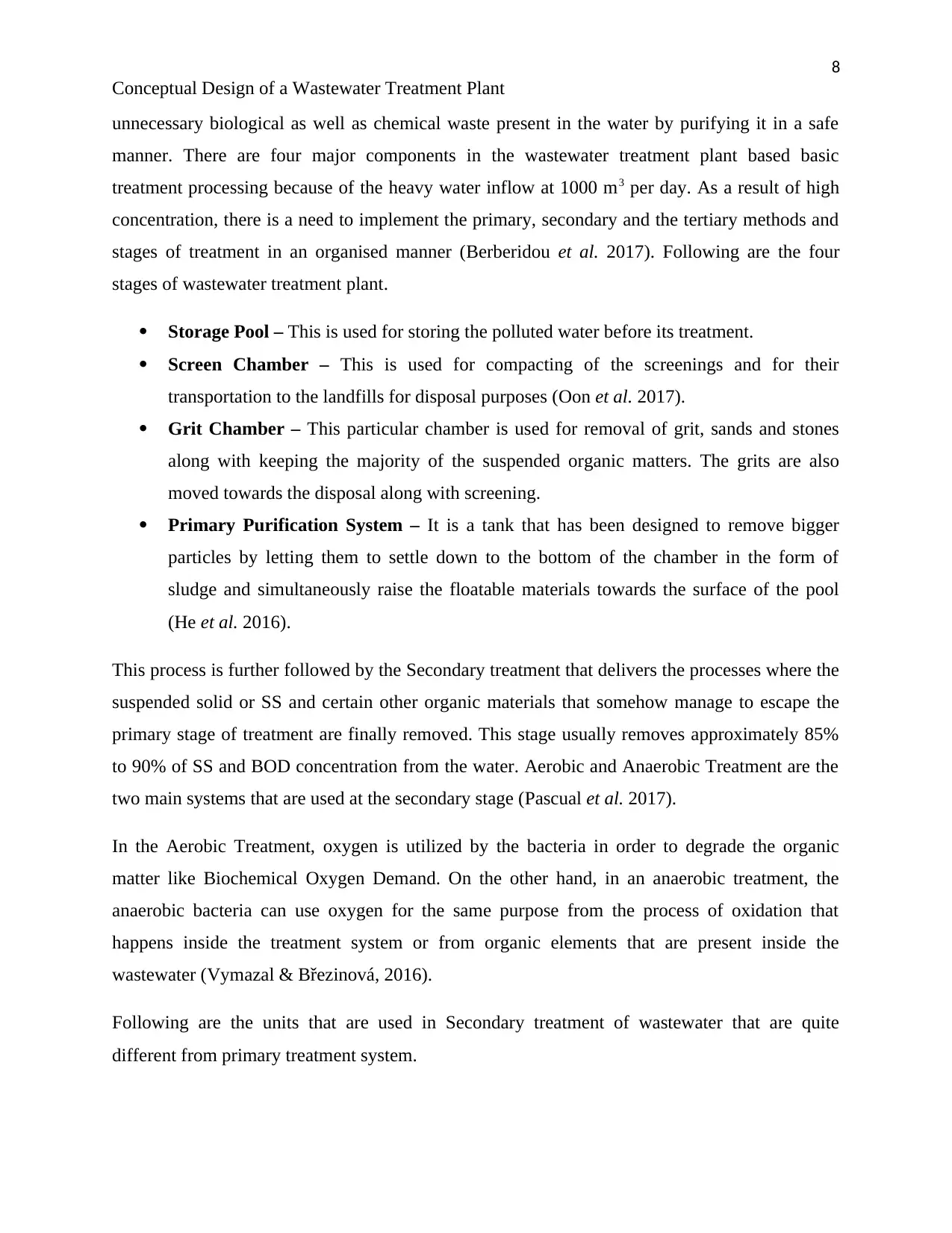
8
Conceptual Design of a Wastewater Treatment Plant
unnecessary biological as well as chemical waste present in the water by purifying it in a safe
manner. There are four major components in the wastewater treatment plant based basic
treatment processing because of the heavy water inflow at 1000 m3 per day. As a result of high
concentration, there is a need to implement the primary, secondary and the tertiary methods and
stages of treatment in an organised manner (Berberidou et al. 2017). Following are the four
stages of wastewater treatment plant.
Storage Pool – This is used for storing the polluted water before its treatment.
Screen Chamber – This is used for compacting of the screenings and for their
transportation to the landfills for disposal purposes (Oon et al. 2017).
Grit Chamber – This particular chamber is used for removal of grit, sands and stones
along with keeping the majority of the suspended organic matters. The grits are also
moved towards the disposal along with screening.
Primary Purification System – It is a tank that has been designed to remove bigger
particles by letting them to settle down to the bottom of the chamber in the form of
sludge and simultaneously raise the floatable materials towards the surface of the pool
(He et al. 2016).
This process is further followed by the Secondary treatment that delivers the processes where the
suspended solid or SS and certain other organic materials that somehow manage to escape the
primary stage of treatment are finally removed. This stage usually removes approximately 85%
to 90% of SS and BOD concentration from the water. Aerobic and Anaerobic Treatment are the
two main systems that are used at the secondary stage (Pascual et al. 2017).
In the Aerobic Treatment, oxygen is utilized by the bacteria in order to degrade the organic
matter like Biochemical Oxygen Demand. On the other hand, in an anaerobic treatment, the
anaerobic bacteria can use oxygen for the same purpose from the process of oxidation that
happens inside the treatment system or from organic elements that are present inside the
wastewater (Vymazal & Březinová, 2016).
Following are the units that are used in Secondary treatment of wastewater that are quite
different from primary treatment system.
Conceptual Design of a Wastewater Treatment Plant
unnecessary biological as well as chemical waste present in the water by purifying it in a safe
manner. There are four major components in the wastewater treatment plant based basic
treatment processing because of the heavy water inflow at 1000 m3 per day. As a result of high
concentration, there is a need to implement the primary, secondary and the tertiary methods and
stages of treatment in an organised manner (Berberidou et al. 2017). Following are the four
stages of wastewater treatment plant.
Storage Pool – This is used for storing the polluted water before its treatment.
Screen Chamber – This is used for compacting of the screenings and for their
transportation to the landfills for disposal purposes (Oon et al. 2017).
Grit Chamber – This particular chamber is used for removal of grit, sands and stones
along with keeping the majority of the suspended organic matters. The grits are also
moved towards the disposal along with screening.
Primary Purification System – It is a tank that has been designed to remove bigger
particles by letting them to settle down to the bottom of the chamber in the form of
sludge and simultaneously raise the floatable materials towards the surface of the pool
(He et al. 2016).
This process is further followed by the Secondary treatment that delivers the processes where the
suspended solid or SS and certain other organic materials that somehow manage to escape the
primary stage of treatment are finally removed. This stage usually removes approximately 85%
to 90% of SS and BOD concentration from the water. Aerobic and Anaerobic Treatment are the
two main systems that are used at the secondary stage (Pascual et al. 2017).
In the Aerobic Treatment, oxygen is utilized by the bacteria in order to degrade the organic
matter like Biochemical Oxygen Demand. On the other hand, in an anaerobic treatment, the
anaerobic bacteria can use oxygen for the same purpose from the process of oxidation that
happens inside the treatment system or from organic elements that are present inside the
wastewater (Vymazal & Březinová, 2016).
Following are the units that are used in Secondary treatment of wastewater that are quite
different from primary treatment system.
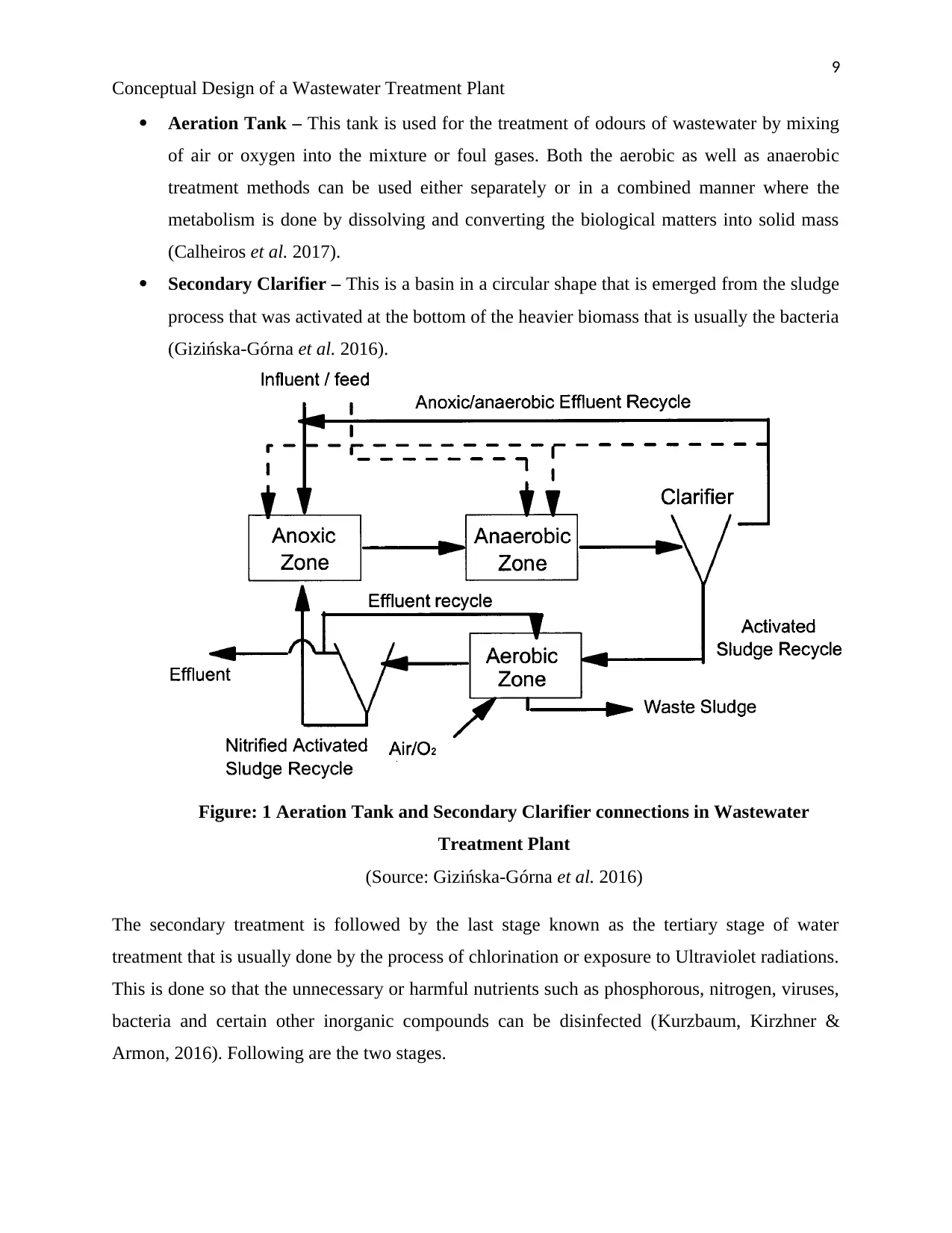
9
Conceptual Design of a Wastewater Treatment Plant
Aeration Tank – This tank is used for the treatment of odours of wastewater by mixing
of air or oxygen into the mixture or foul gases. Both the aerobic as well as anaerobic
treatment methods can be used either separately or in a combined manner where the
metabolism is done by dissolving and converting the biological matters into solid mass
(Calheiros et al. 2017).
Secondary Clarifier – This is a basin in a circular shape that is emerged from the sludge
process that was activated at the bottom of the heavier biomass that is usually the bacteria
(Gizińska-Górna et al. 2016).
Figure: 1 Aeration Tank and Secondary Clarifier connections in Wastewater
Treatment Plant
(Source: Gizińska-Górna et al. 2016)
The secondary treatment is followed by the last stage known as the tertiary stage of water
treatment that is usually done by the process of chlorination or exposure to Ultraviolet radiations.
This is done so that the unnecessary or harmful nutrients such as phosphorous, nitrogen, viruses,
bacteria and certain other inorganic compounds can be disinfected (Kurzbaum, Kirzhner &
Armon, 2016). Following are the two stages.
Conceptual Design of a Wastewater Treatment Plant
Aeration Tank – This tank is used for the treatment of odours of wastewater by mixing
of air or oxygen into the mixture or foul gases. Both the aerobic as well as anaerobic
treatment methods can be used either separately or in a combined manner where the
metabolism is done by dissolving and converting the biological matters into solid mass
(Calheiros et al. 2017).
Secondary Clarifier – This is a basin in a circular shape that is emerged from the sludge
process that was activated at the bottom of the heavier biomass that is usually the bacteria
(Gizińska-Górna et al. 2016).
Figure: 1 Aeration Tank and Secondary Clarifier connections in Wastewater
Treatment Plant
(Source: Gizińska-Górna et al. 2016)
The secondary treatment is followed by the last stage known as the tertiary stage of water
treatment that is usually done by the process of chlorination or exposure to Ultraviolet radiations.
This is done so that the unnecessary or harmful nutrients such as phosphorous, nitrogen, viruses,
bacteria and certain other inorganic compounds can be disinfected (Kurzbaum, Kirzhner &
Armon, 2016). Following are the two stages.
⊘ This is a preview!⊘
Do you want full access?
Subscribe today to unlock all pages.

Trusted by 1+ million students worldwide
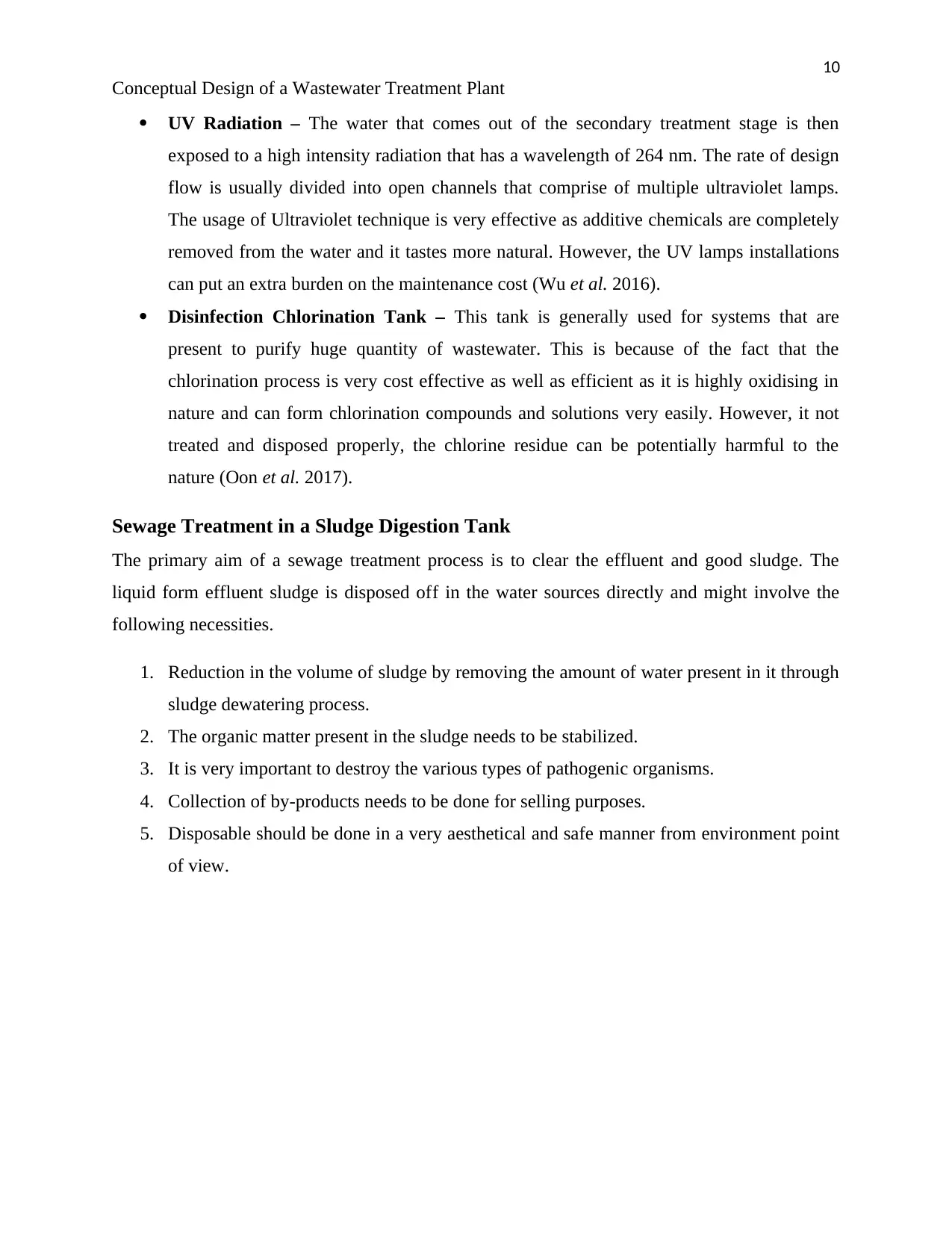
10
Conceptual Design of a Wastewater Treatment Plant
UV Radiation – The water that comes out of the secondary treatment stage is then
exposed to a high intensity radiation that has a wavelength of 264 nm. The rate of design
flow is usually divided into open channels that comprise of multiple ultraviolet lamps.
The usage of Ultraviolet technique is very effective as additive chemicals are completely
removed from the water and it tastes more natural. However, the UV lamps installations
can put an extra burden on the maintenance cost (Wu et al. 2016).
Disinfection Chlorination Tank – This tank is generally used for systems that are
present to purify huge quantity of wastewater. This is because of the fact that the
chlorination process is very cost effective as well as efficient as it is highly oxidising in
nature and can form chlorination compounds and solutions very easily. However, it not
treated and disposed properly, the chlorine residue can be potentially harmful to the
nature (Oon et al. 2017).
Sewage Treatment in a Sludge Digestion Tank
The primary aim of a sewage treatment process is to clear the effluent and good sludge. The
liquid form effluent sludge is disposed off in the water sources directly and might involve the
following necessities.
1. Reduction in the volume of sludge by removing the amount of water present in it through
sludge dewatering process.
2. The organic matter present in the sludge needs to be stabilized.
3. It is very important to destroy the various types of pathogenic organisms.
4. Collection of by-products needs to be done for selling purposes.
5. Disposable should be done in a very aesthetical and safe manner from environment point
of view.
Conceptual Design of a Wastewater Treatment Plant
UV Radiation – The water that comes out of the secondary treatment stage is then
exposed to a high intensity radiation that has a wavelength of 264 nm. The rate of design
flow is usually divided into open channels that comprise of multiple ultraviolet lamps.
The usage of Ultraviolet technique is very effective as additive chemicals are completely
removed from the water and it tastes more natural. However, the UV lamps installations
can put an extra burden on the maintenance cost (Wu et al. 2016).
Disinfection Chlorination Tank – This tank is generally used for systems that are
present to purify huge quantity of wastewater. This is because of the fact that the
chlorination process is very cost effective as well as efficient as it is highly oxidising in
nature and can form chlorination compounds and solutions very easily. However, it not
treated and disposed properly, the chlorine residue can be potentially harmful to the
nature (Oon et al. 2017).
Sewage Treatment in a Sludge Digestion Tank
The primary aim of a sewage treatment process is to clear the effluent and good sludge. The
liquid form effluent sludge is disposed off in the water sources directly and might involve the
following necessities.
1. Reduction in the volume of sludge by removing the amount of water present in it through
sludge dewatering process.
2. The organic matter present in the sludge needs to be stabilized.
3. It is very important to destroy the various types of pathogenic organisms.
4. Collection of by-products needs to be done for selling purposes.
5. Disposable should be done in a very aesthetical and safe manner from environment point
of view.
Paraphrase This Document
Need a fresh take? Get an instant paraphrase of this document with our AI Paraphraser
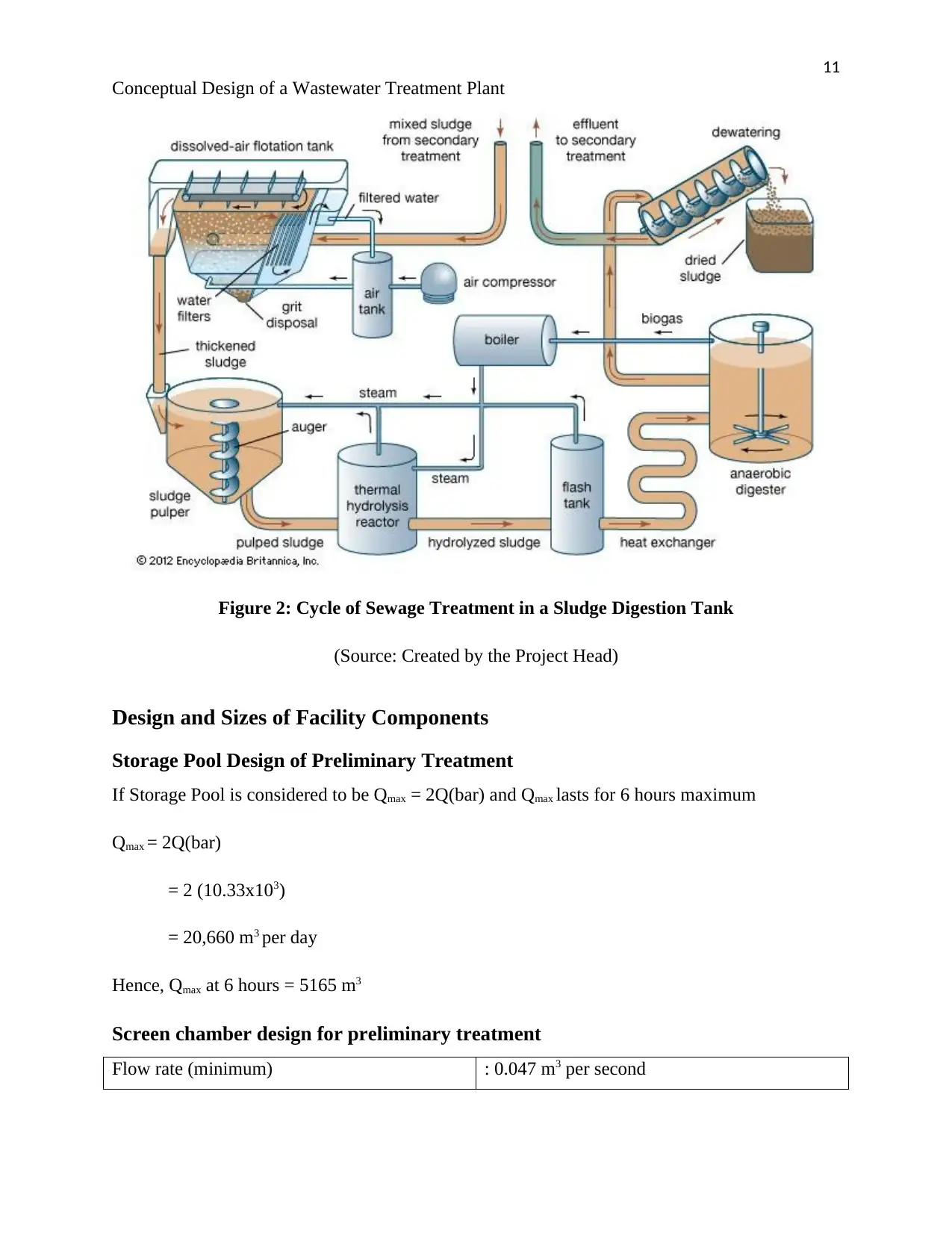
11
Conceptual Design of a Wastewater Treatment Plant
Figure 2: Cycle of Sewage Treatment in a Sludge Digestion Tank
(Source: Created by the Project Head)
Design and Sizes of Facility Components
Storage Pool Design of Preliminary Treatment
If Storage Pool is considered to be Qmax = 2Q(bar) and Qmax lasts for 6 hours maximum
Qmax = 2Q(bar)
= 2 (10.33x103)
= 20,660 m3 per day
Hence, Qmax at 6 hours = 5165 m3
Screen chamber design for preliminary treatment
Flow rate (minimum) : 0.047 m3 per second
Conceptual Design of a Wastewater Treatment Plant
Figure 2: Cycle of Sewage Treatment in a Sludge Digestion Tank
(Source: Created by the Project Head)
Design and Sizes of Facility Components
Storage Pool Design of Preliminary Treatment
If Storage Pool is considered to be Qmax = 2Q(bar) and Qmax lasts for 6 hours maximum
Qmax = 2Q(bar)
= 2 (10.33x103)
= 20,660 m3 per day
Hence, Qmax at 6 hours = 5165 m3
Screen chamber design for preliminary treatment
Flow rate (minimum) : 0.047 m3 per second
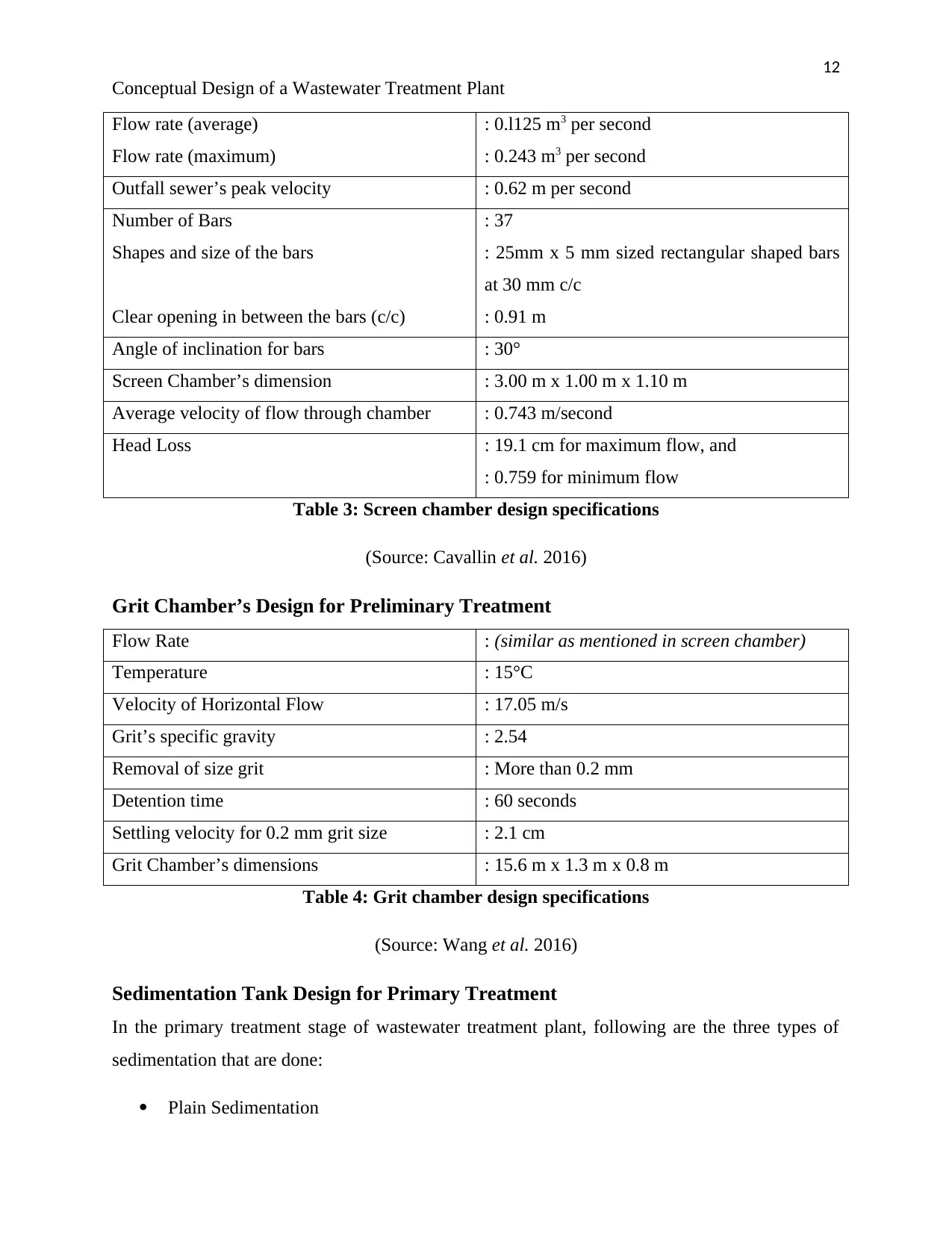
12
Conceptual Design of a Wastewater Treatment Plant
Flow rate (average)
Flow rate (maximum)
: 0.l125 m3 per second
: 0.243 m3 per second
Outfall sewer’s peak velocity : 0.62 m per second
Number of Bars
Shapes and size of the bars
Clear opening in between the bars (c/c)
: 37
: 25mm x 5 mm sized rectangular shaped bars
at 30 mm c/c
: 0.91 m
Angle of inclination for bars : 30°
Screen Chamber’s dimension : 3.00 m x 1.00 m x 1.10 m
Average velocity of flow through chamber : 0.743 m/second
Head Loss : 19.1 cm for maximum flow, and
: 0.759 for minimum flow
Table 3: Screen chamber design specifications
(Source: Cavallin et al. 2016)
Grit Chamber’s Design for Preliminary Treatment
Flow Rate : (similar as mentioned in screen chamber)
Temperature : 15°C
Velocity of Horizontal Flow : 17.05 m/s
Grit’s specific gravity : 2.54
Removal of size grit : More than 0.2 mm
Detention time : 60 seconds
Settling velocity for 0.2 mm grit size : 2.1 cm
Grit Chamber’s dimensions : 15.6 m x 1.3 m x 0.8 m
Table 4: Grit chamber design specifications
(Source: Wang et al. 2016)
Sedimentation Tank Design for Primary Treatment
In the primary treatment stage of wastewater treatment plant, following are the three types of
sedimentation that are done:
Plain Sedimentation
Conceptual Design of a Wastewater Treatment Plant
Flow rate (average)
Flow rate (maximum)
: 0.l125 m3 per second
: 0.243 m3 per second
Outfall sewer’s peak velocity : 0.62 m per second
Number of Bars
Shapes and size of the bars
Clear opening in between the bars (c/c)
: 37
: 25mm x 5 mm sized rectangular shaped bars
at 30 mm c/c
: 0.91 m
Angle of inclination for bars : 30°
Screen Chamber’s dimension : 3.00 m x 1.00 m x 1.10 m
Average velocity of flow through chamber : 0.743 m/second
Head Loss : 19.1 cm for maximum flow, and
: 0.759 for minimum flow
Table 3: Screen chamber design specifications
(Source: Cavallin et al. 2016)
Grit Chamber’s Design for Preliminary Treatment
Flow Rate : (similar as mentioned in screen chamber)
Temperature : 15°C
Velocity of Horizontal Flow : 17.05 m/s
Grit’s specific gravity : 2.54
Removal of size grit : More than 0.2 mm
Detention time : 60 seconds
Settling velocity for 0.2 mm grit size : 2.1 cm
Grit Chamber’s dimensions : 15.6 m x 1.3 m x 0.8 m
Table 4: Grit chamber design specifications
(Source: Wang et al. 2016)
Sedimentation Tank Design for Primary Treatment
In the primary treatment stage of wastewater treatment plant, following are the three types of
sedimentation that are done:
Plain Sedimentation
⊘ This is a preview!⊘
Do you want full access?
Subscribe today to unlock all pages.

Trusted by 1+ million students worldwide
1 out of 23
Your All-in-One AI-Powered Toolkit for Academic Success.
+13062052269
info@desklib.com
Available 24*7 on WhatsApp / Email
![[object Object]](/_next/static/media/star-bottom.7253800d.svg)
Unlock your academic potential
Copyright © 2020–2025 A2Z Services. All Rights Reserved. Developed and managed by ZUCOL.
